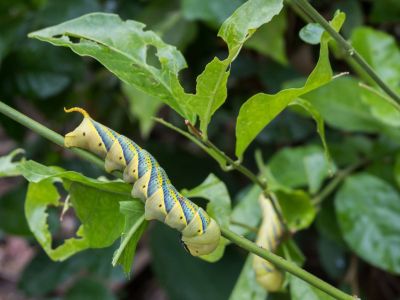Pests of Jasmine
There are two main types of jasmine plant pests. The sucking insects, like aphids, are those whose feeding behavior entails piercing the plant material and eating the sap. There are also foliage insects which cause visual damage to the leaves of a plant. Most of these are caterpillars and larvae of a variety of moths and butterflies but a few represent other invertebrates. Pests affecting jasmine plants vary in size and degree of damage but it is best to establish some basic methods of dealing with the invaders.
Jasmine Plant Pests of Foliage
The budworm is a small white moth whose larva feed off of the buds of the jasmine plant, effectively destroying the flowers. The gallery worm tunnels in and around the buds and builds silk lined caves. Leaf rollers do just what it sounds like they do, while leaf webworms cover both foliage and twigs in silk webs. A tiny mite is also responsible for leaf damage. The mite tunnels under the top layer of the leaf and leaves bumps and ridges in the epidermal surface. Sometimes the leaf even distorts and deforms. Most foliar pests can be combated with horticultural soap or oil. Treat at the first signs of damage or for preemptive measures in early spring at bud break.
Jasmine Plant Pests That Suck-Literally
Sadly, insect pests are fond of your ornamental plants and a host of sucking insects can sap the vitality of your jasmine. Jasmine plant pest control on this variety requires vigilance and fortitude. Whiteflies, scale, mites and a host of other “ickies” do more than damage the appearance of your bush. They feed on the life-giving juices of the jasmine and reduce its ability to store and receive important moisture and nutrients. Most of these pests are so tiny they are not easily spotted and are more easily identified by plant decline. This may include brown streaking on stems as in thrip damage, yellow leaves which occur with whitefly and several other deteriorating conditions. If you are in doubt as to which pest is your problem, use a magnifying glass or place a piece of white paper under the plant and shake. The tiny insects that fall can be investigated more thoroughly to tell which bad guy is causing the problem. With any pest problem, try non-toxic methods initially. A soapy solution of water and dish soap can clog up most pests’ breathing areas and kill a large amount of the population. Resort to target pesticides if you can identify the insect to prevent killing beneficial plants. Overall, treat your jasmine like a queen so it is healthy and able to withstand occasional onslaughts from tiny invaders.
